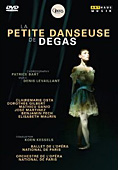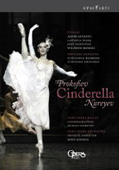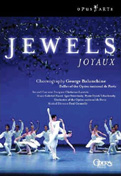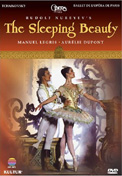BALLET ON DVD
All ballet books are delivered worldwide by Amazon USA.

|
Paris Opera Ballet
 Degas: La Petite Danseuse De Degas - Paris Opera Ballet (2011)
Degas: La Petite Danseuse De Degas - Paris Opera Ballet (2011)

Clairemarie Osta (The Little Dancer), Dorothée Gilbert (The Etoile Dancer), Mathieu Ganio (The Ballet Master), José Martinez (The Subscription Holder),´Benjamin Pech (The Man in Black).
Paris Opera Ballet Master and choreographer Patrice Bart plunges into the Opera‘s past and brings Degas‘ famous statuette to life. From the rehearsal rooms to the Cabaret du Chat Noir, the ballet conjures up a colourful era and the lively backstage world of a theatre. The creation of La Petite Danseuse de Degas was the fruit of a long process dating back to 1997, when Martine Kahane, Head Curator and Director of the Paris Opera’s cultural department, presented an exhibition on the tutu at the Palais Garnier. Not long after, the Musée d’Orsay contacted her and asked her to work with the Opera costume workshop to restore the tutu adorning Edgar Degas’ famous statue. In the research that followed, she began to wonder about the identity of the model.
|
 Cinderella - Paris Opera Ballet (2007)
Cinderella - Paris Opera Ballet (2007)

Rudolf Nureyev's colorful, cinematic-dream version of Prokofiev's Cinderella retains the classic Perrault story but sets it in America during the difficult years of the Great Depression in the 1930s and 1940s. Agnes Letestu stars as Cinderella who, living with her alcoholic father, tyrannical stepmother and two spiteful stepsisters, dreams of escape and stardom in Hollywood. After a promising screen-test during which The Film Star, suavely portrayed by Jose Martinez, falls head over heels in love with her, she is fearful that her new-found happiness is too good to be true and will vanish with her youth. Fortunately, her magical protector (in the form of The Producer) and her lover move heaven and earth for a 'happily ever after' ending.
|
 Balanchine - Jewels / Aurelie Dupont, Alessio Carbone, Marie-Agnes Gillot, Agnes Letestu, Jean-Guillaume Bart, Clairemarie Osta, Kader Belarbi, Paris Opera Ballet
Balanchine - Jewels / Aurelie Dupont, Alessio Carbone, Marie-Agnes Gillot, Agnes Letestu, Jean-Guillaume Bart, Clairemarie Osta, Kader Belarbi, Paris Opera Ballet
George Balanchine's 1967 masterpiece, a triptych of three abstract ballets to music by Fauré, Stravinsky, and Tchaikovsky, with a stellar cast including Aurélie Dupont, Marie-Agnès Gillot, Agnès Letestu, Clairemarie Osta, Laëtitia Pujol, Jean-Guillaume Bart, Kader Belarbi, and Mathie Ganio. Also included on the DVD is an hour-long documentary, George Balanchine Forever, featuring interviews with Brigitte Lefère, designer Christian Lacroix, Chairman of the Balanchine Foundation Barbara Horgan, and dancers from the production of Jewels.
|
 The Sleeping Beauty / Aurelie Dupont, Manuel Legris, Paris Opera Ballet
The Sleeping Beauty / Aurelie Dupont, Manuel Legris, Paris Opera Ballet
Choreographed and staged by Rudolf Nureyev after Marius Petipa. Restaged by Patricia Ruanne.
The Sleeping Beauty remains, as Rudolf Nureyev often called it, the ‘ballet of ballets’. It is the most accomplished and the most brilliant, as well as one of the most spectacular of the 19th century, and the most representative of the ‘noble’ style of classical dancing. Rudolf Nureyev's version, which he created for the Opera Ballet in 1989, was recorded at the Opéra Bastille in 1999, in a new production (sets and costumes) created by his faithful collaborators, Ezio Frigerio and Franca Squarciapino, who had already produced Swan Lake, Romeo And Juliet and La Bayadère.
|
 Sylvia - Aurelie Dupont, Manuel Legris, Nicolas Le Riche, Marie-Agnes Gillot, Jose Martinez, Paris Opera Ballet (2006)
Sylvia - Aurelie Dupont, Manuel Legris, Nicolas Le Riche, Marie-Agnes Gillot, Jose Martinez, Paris Opera Ballet (2006)
The longstanding and enormously successful Ballet Director of the Hamburg Ballet, John Neumeier, created his famous adaptation of Sylvia in 1997 on invitation for the Paris Ballet. TDK presents a performance of this choreography from the Opéra de Paris with a line-up of soloists that includes some of the best dancers of today: Aurélie Dupont, Marie-Agnès Gillot; Manuel Legris, Nicolas Le Riche and José Martinez, all étoiles at the Paris Ballet and stars of the international dance scene. Neumeier's contemporary choreography, created with the Opéra de Paris ballet, transforms Sylvia into a modern parable about the difficulties of loving. The characters are stripped of their mythological trappings to take on a more human, more universal dimension. Supported by the cautiously simple but very effective stage and costume design by the Greek painter Yannis Kokkos, emphasising the dancing rather than dominating it, John Neumeier has created a ballet that is as timeless as the mythological fable it portrays.
|
 La Sylphide / Aurelie Dupont, Mathieu Ganio
La Sylphide / Aurelie Dupont, Mathieu Ganio
Pierre Lacotte’s 1972 reconstruction returned to the very roots of Taglioni’s work. Whilst writing a book on romantic ballet in 1968, he had discovered documents about Philippe Taglioni's 1832 La Sylphide, which enabled him to reconstruct the work. Originally produced for television in 1971, it was subsequently transferred to the stage when the Paris Opera invited Lacotte and the dancers Ghislaine Thesmar and Michael Denard to repeat the performance at the Palais Garnier on 9 June 1972. It had not appeared in the Paris Opera’s repertoire for over a century but after Lacotte’s careful reconstruction, this choreographic masterpiece became standard repertory in companies from Helsinki to Tokyo, from Buenos Aires to Prague.
In 2004, the Paris Opera Ballet revived this classic reconstruction, now to be released on DVD. The revival also paid tribute to Marie Taglioni, the first Sylphide ever, on the bicentenary of her birth. This time, Aurélie Dupont, one of the most cherished prima ballerinas worldwide, created the title role. She was partnered by Mathieu Ganio, the youngest etoile of the Paris company and expected to be the next star of international ballet.
|
 Diaghilev, Cocteau - Picasso and Dance / Paris Opera Ballet
Diaghilev, Cocteau - Picasso and Dance / Paris Opera Ballet
Le Train Bleu (The Blue Train): Scenario by Jean Cocteau, Music by Darius Milhaud. Perlouse: Élisabeth Maurin, The Handsome Youth: Nicholas Le Riche, The Tennis Champion: Clotilde Vayer, The Golfer: Laurent Quéval. Le Train Bleu is an operetta dansé of a chic and flippant society. Jean Cocteau, who wrote the scenario, mockingly celebrates the cult of open air life, fine bodies and sport. The dances are inspired by golf, tennis, swimming and acrobatics.
Le Tricorne (The Three-Cornered Hat): Libretto by Gregorio Martinez Sierra, Music by Manuel De Falla, Choreography by Léonide Massine, Stage Curtain, Sets & Costumes by Pablo Picasso. The Miller: Kader Belarbi, The Miller’s Wife: Françoise Legrée, Magistrate: Fabrice Bourgeois. Le Tricorne is Spanish from start to finish. Picasso, a native of Andalusia, created sets, costumes, and a stage curtain, which evokes the atmosphere of the ballet by means of a typically Spanish scene.
|
 Minkus - La Bayadere / Guerin, Hilaire, Platel, Paris Ballet
Minkus - La Bayadere / Guerin, Hilaire, Platel, Paris Ballet
Exotic and mysterious India serves as the backdrop to this story of doomed love between the warrior Solor and the bayadère, Nikiya, who is killed by her jealous rival, Gamzatti. Breathtaking sets and costumes are designed by Ezio Frigerio and Franca Squarciapino in this exceptional production, recorded at the Palais Garnier in Paris. Direction and choreography in this fully restored version of Petipa's original ballet are by Rudolf Nureyev. Stars Isabelle Guérin, Laurent Hilaire, and Élisabeth Platel.
|
 Clavigo / Le Riche, Osta, Gillot, Paris Opera Ballet
Clavigo / Le Riche, Osta, Gillot, Paris Opera Ballet
Inspired by Goethe’s early romantic play Clavigo, Roland Petit’s ballet recounts the agonies of a weak-willed lover torn between the contradictory promptings of his heart and his evil spirit, which urges him to serve his own interests and forsake true love in favor of a life of debauchery. The title role was created by Nicolas Le Riche, one of the foremost dancers of today. Petit’s outstanding choreography is inventive, with powerful images, such as Clavigo’s spider-like descent on a wire. The superb and passionate dancing is set off by the structured stage design in grey, black or white panels and the beautiful late-18th-century-style pastel costumes, creating a feast for the eyes.
|
 Dancer's Dream: The Great Ballets of Rudolf Nureyev - Raymonda
Dancer's Dream: The Great Ballets of Rudolf Nureyev - Raymonda
When Nureyev took up the position of Artistic Director of the ballet of the Paris opera in 1983, his words to the dancers of the ensemble so rich in tradition were, "Don’t talk, work", and only two months later he presented his magnificent new production of Marius Petipa’s oriental ballet Raymonda. This documentary by François Roussillon examines the various aspects of this ballet, which has become a classic in the repertoire of the ballet ensemble of the Paris opera through Rudolf Nureyev’s choreography. It was made in 1998 in honor of the great ballerina Yvette Chauviré and gives the dancers and other performers who during the fifteen years since the premiere of Nureyev’s choreography in 1983 have established the success of the ballet, a chance to speak. Their reminiscences are illustrated by numerous excerpts from various performances and rehearsals. Nureyev was a workaholic, but he succeeded as did no other to pass on his enthusiasm and passion for the classical dance to young dancers. Everyone who worked with him confirms this, beginning with Elisabeth Platel, the Raymonda of 1983, and Charles Jude to Claude de Vulpian and Manuel Legris, the stars of the New York performance of Raymonda in 1986. Nureyev’s innate talent for dancing and the perfection of his rehearsal work has made Raymonda one of the greatest masterworks of ballet history.
|
 Dancer's Dream: The Great Ballets of Rudolf Nureyev - Romeo and Juliet Documentary
Dancer's Dream: The Great Ballets of Rudolf Nureyev - Romeo and Juliet Documentary
A documentary in which the Paris Opera Ballet rehearse, dance excerpts from, and discuss Rudolf Nureyev's version of Romeo and Juliet. The cast includes Elisabeth Maurin as Juliet, Manuel Legris as Romeo, Kader Belarbi as Tybalt, Lionel Delamoe as Mercutio, Yann Bridard as Benvolio, and Jean-Guillaume Bart as Paris, and the rehearsal director is Patricia Ruanne. The commentary is in French, but subtitles are provided in English, German, Italian, and Spanish.
|
|

